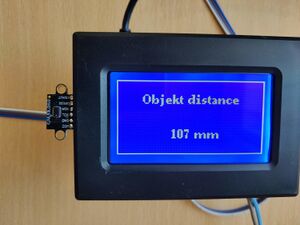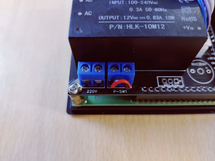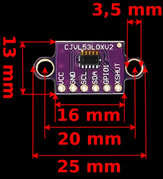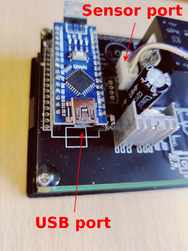LaserDistanceLCD
Overview
LaserDistanceLCD is a panel-mounted measuring device. It uses laser light to measure the distance between the sensor and the object. The measurement is based on the ToF (time of flight) of light from the source (sensor) and is the reflection (object).
The measured distances can be shown in millimeters (mm) or inches (inch) in 18 different languages. Configuration of a device is made with LaserDistance software.
Hardware installation
The LaserDistanceLCD has to be mounted on a panel. The hole diameters have to be 97 x 72mm. The backside of the device is 45mm deep, so leave enough place to connect the cables. Powering off the device can be done with 220VAC or 110VAC. The sensor is connected with a 1-meter-long flat cable to the device.
By the installation place, please note that a device is about 45mm bold, so You have to leave enough place to access the cables and connectors from the sensor and from the programmer.
The sensor has two mounting holes, 20mm distance. By the mounting of the sensor, note that it needs to have a clear view of the measured object. Don't install the device in a humid environment, water tanks, etc. Also, the device must be used indoors and is not made for outdoor usage. Presents of high dust can affect the measurement. The possibility to reflect laser light can affect the measuring range.
Powering
LaserDistanceLCD uses 220VAC for powering. The power connector is on the back side in the bottom left corner, marked on the PCB with "220V". Next to the powering terminal screw, is the switching port, marked on the PCB with "P-SW1". It interrupts the powering of the device. If You need this function, just install an interrupter for 220VAC. In case You don't need this function, just shortcut it, because if You remove the wire on that connector, the device still stays in a not powered state. For the wiring, use 1.5mm2 cable, the maximal current that a device need is under 300mA at 220VAC.
Sensor installation
Sensing of the distance is done with the Time of Flight technique (ToF), provided by the STMicroelectronics VL53L0X ranging sensor. It has a measuring range of up to 1200mm in ideal condition.
The sensor has to be mounted with two screws to the "zero point", looking at the 90° to the measured object. The sensor uses 5VDC to power and communicate with the I2C protocol.
The sensor is connected with an JST-XH 4 pin connector to the PCB, over one 1 meter long flat cable.
Configuration
For the configuration of the device, You must connect the USB cable to the device and to a computer with the installed LaserDistance software. In a time of the configuration, the device don't need to be powered over 220VAC, but it can be powered.
After You connected the device, start the program, scan for ports and connect to the port of the LaserDistanceLCD device. If the device was connected, You can see the device picture in left bottom corner, and the measured value in right bottom corner. Current configuration can be saved to a file for a backup or for later changes.
In the LaserDistance software, You can configure two parameters, the measurement units and the LCD panguage. After You changed any parameter, just save it into the device. You don't need to restart the device after it, the changes will be presented inmediately after You save the changes into the device.
Measurement units
By measuring, the device can present the results in millimeters or in inches. Millimeters are SI units while inches are imperial units. The choosed unit will be presented on the LCD panel and in the software window. Also, if You made a measurement into CSV file, it will save in value that is configured in the device.
Language
The LaserDistanceLCD supports 18 languages: English, German, French, Italian, Portuguese, Spanish, Dutch, Hungarian, Croatian, Slovenian, Serbian, Czech, Slovak, Polish, Danish, Swedish, Norwegian and Finnish. If You made the changes save it into the device.
Maintenance
The device don't require any special maintenance. To have an accurate measurement, check always is the sensor free of dust. If is covered with dust, You will have false measurements. Is important that no other foreign object have to bee between the measuring sensor and the measuring object.



